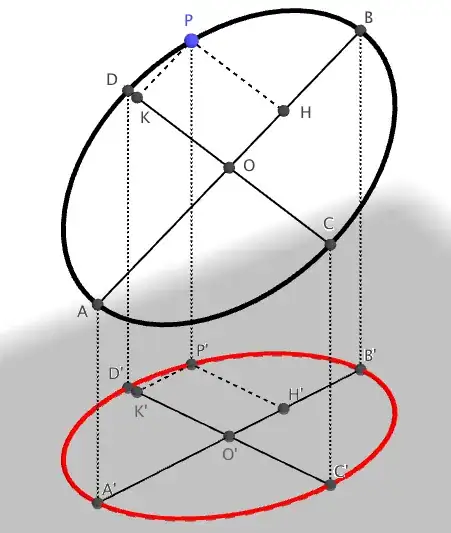Problem
If you take a photograph of an eclipse, is it still a conic curve on the image?
Solution
Yes.
To project a point in 3D space into a 2D canvas, the canonical way of doing that in computer graphics is:
Step 1. make a "view-projection transformation", which maps the points $(x,y,z)$ from the "world space" into the points in the "clip space" $(X,Y,Z)$. In particular, it is a projective transformation that
maps a viewing frustum (the region your camera is looking at) to a cube.
It is done by using homogeneous coordinates:
\begin{equation}
\begin{bmatrix}
\tilde{X} \\ \tilde{Y} \\ \tilde{Z} \\ \tilde{W}
\end{bmatrix}
=
P \cdot
\begin{bmatrix}
x \\ y \\ z \\ 1
\end{bmatrix}
\end{equation}
\begin{equation}
\begin{bmatrix}
X \\ Y \\ Z
\end{bmatrix}
=
\begin{bmatrix}
\tilde{X}/\tilde{W} \\
\tilde{Y}/\tilde{W} \\
\tilde{Z}/\tilde{W}
\end{bmatrix}
\end{equation}
Where $P$ is an invertible matrix based on the position, orientation, and FOV of the camera.
Step 2. in the "clip space", make an orthogonal projection onto the $Z=0$ plane:
\begin{equation}
(X,Y,Z) \mapsto (X,Y)
\end{equation}
it is easy to show that step 2 maps a 3D conic curve into a 2D one. So let's take a look at whether step 1 maps a 3D conic curve to another 3D conic curve.
A conic curve in 3D space can be written as the intersection of a quadric surface with a plane:
\begin{equation}
\left\{
\begin{array}{c}
v^T \cdot M \cdot v=0 \\
N \cdot v=0
\end{array}
\right.,
v=
\begin{bmatrix}
x \\ y \\ z \\ 1
\end{bmatrix}
\end{equation}
Where $M$ as a 4x4 matrix, N is a 1x4 vector
by replacing
\begin{equation}
V= \tilde{W}(x,y,z)^{-1} P \cdot v,
V=
\begin{bmatrix}
X \\ Y \\ Z \\ 1
\end{bmatrix}
\end{equation}
The equation defining the set of points on the curve becomes:
\begin{equation}
\left\{
\begin{array}{c}
\tilde{W}(X,Y,Z)^{2} V^T \cdot P^{-1,T} \cdot M \cdot P^{-1} \cdot V=0 \\
\tilde{W}(X,Y,Z) N \cdot P^{-1} \cdot v=0
\end{array}
\right.
\end{equation}
The key step is that, although $\tilde{W}$ has a complex dependence on $(X,Y,Z)$, it can be removed from the equation as a scalar multiplier, since RHS is zero. The remaining part is a constant matrix. Then we reached a similar form:
\begin{equation}
\left\{
\begin{array}{c}
V^T \cdot M' \cdot V=0 \\
N' \cdot v=0
\end{array}
\right.,
M'= P^{-1,T} \cdot M \cdot P^{-1},
N'= N \cdot P^{-1}
\end{equation}
So the conic curve is still a conic curve after the "view-project" transformation, which remains a conic curve after the final orthogonal projection.
